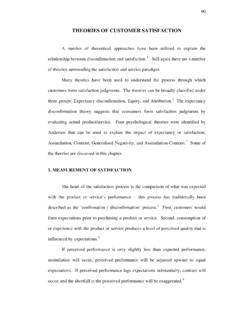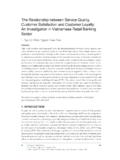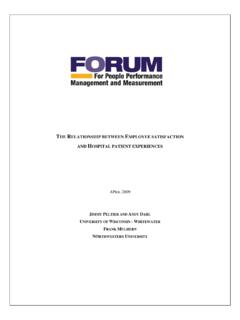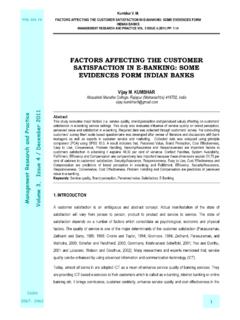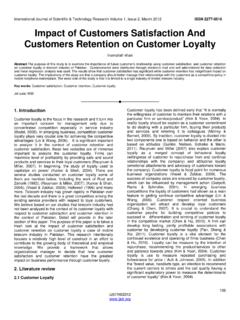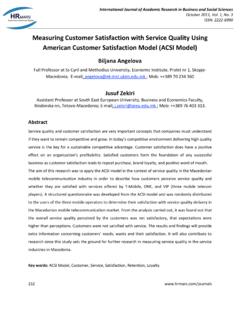Transcription of Understanding Relationship Marketing Outcomes …
1 JOURNAL OF SERVICE. Hennig-Thurau RESEARCH et / February al. / Relationship . 2002 Marketing Outcomes . Understanding Relationship Marketing Outcomes An Integration of Relational Benefits and Relationship Quality Thorsten Hennig-Thurau University of Hanover Kevin P. Gwinner Kansas State University Dwayne D. Gremler Bowling Green State University The importance of developing and maintaining enduring to significantly contribute to Relationship Marketing out- relationships with customers of service businesses is gen- comes in services. erally accepted in the Marketing literature. A key chal- lenge for researchers is to identify and understand how managerially controlled antecedent variables influence important Relationship Marketing Outcomes ( , cus- Nearly two decades have passed since the first mention tomer loyalty and word-of-mouth communication). Rela- of the Relationship Marketing concept by Berry (1983), but tional benefits, which have a focus on the benefits the concept is still in vogue, maybe more than ever.
2 Brown consumers receive apart from the core service, and rela- (1997) observed, not without a touch of irony, that tionship quality, which focuses on the overall nature of the Relationship , represent two approaches to Understanding faced with the prospect of missing the last train to customer loyalty and word of mouth. This article inte- scientific respectability, many Marketing academ- grates these two concepts by positioning customer satis- ics .. are desperately rummaging through their past faction and commitment as Relationship quality publications and rejected manuscripts in a frantic dimensions that partially mediate the Relationship be- search for the magic word, the word which will en- able them to announce that they have been relation- tween three relational benefits (confidence benefits, social ship marketers all along and are thus entitled to a benefits, and special treatment benefits) and the two out- seat on board.
3 (p. 171). come variables. The results provide support for the model and indicate that the concepts of customer satisfaction, The concept has found its place in Marketing theory and commitment, confidence benefits, and social benefits serve has become an integral part of standard textbooks on mar- Journal of Service Research, Volume 4, No. 3, February 2002 230-247. 2002 Sage Publications [Note: This paper received the Excellence in Service Research Award from the Journal of Service Research for the best article of Volume 4.]. Hennig-Thurau et al. / Relationship Marketing Outcomes 231. keting ( , Kotler 1997) and consumer behavior ( , 336 service customers is then presented, against which the Sheth, Mittal, and Newman 1999). All in all, using the vo- theoretical framework is tested with structural equation cabulary of life cycle theory, the concept of Relationship modeling. Finally, the results of the analysis are reported, Marketing is approaching its maturity stage (Berry 1995).
4 Their practical relevance for service marketers is dis- A key goal of Relationship Marketing theory is the iden- cussed, and suggestions are derived for future research. tification of key drivers that influence important Outcomes for the firm and a better Understanding of the causal rela- tions between these drivers and Outcomes . In the market- THEORETICAL BACKGROUND. ing literature, several different approaches have been used to identify these variables and to learn about their impact Relationship Marketing Outcomes on relational Outcomes . Most of the existing approaches focus on a single predictor variable ( , customer satis- All Relationship Marketing activities are ultimately faction) and investigate its connection with relational out- evaluated on the basis of the company's overall profitabil- comes, rather than developing multivariate models and ity. However, as a firm's profitability is influenced by a theories.
5 However, a review of the existing work on the de- number of variables largely independent of Relationship terminants of Relationship Marketing Outcomes reveals Marketing activities, it seems appropriate to conceptualize some promising conceptual models that might explain a Relationship Marketing Outcomes on a more concrete level significant amount of the success (or failure) of relation- when investigating possible antecedents. Two constructs ships between service providers and their customers. Two are referred to in the Marketing literature as key relation- of the most promising conceptual approaches are (a) the ship Marketing Outcomes : customer loyalty and (positive). relational benefits approach ( , Bendapudi and Berry customer word-of-mouth communication. 1997; Gwinner, Gremler, and Bitner 1998; Reynolds and customer loyalty, as we conceptualize it, focuses on a Beatty 1999a) and (b) the Relationship quality approach customer 's repeat purchase behavior that is triggered by a ( , Crosby 1991; Crosby, Evans, and Cowles 1990; marketer's activities.)
6 Evolving out of, and contradictory Dorsch, Swanson, and Kelley 1998; Smith 1998). The re- to, early definitions that were solely behavioral, customer lational benefits approach argues that categories of rela- loyalty today is usually viewed as comprising both behav- tionship-oriented customer benefits exist, the fulfillment ioral and attitudinal components (Day 1969; Jacoby and of which can predict the future development of existing re- Kyner 1973). Loyalty is a primary goal of Relationship lationships. The Relationship quality approach is based on Marketing and sometimes even equated with the relation- the assumption that customer loyalty is largely determined ship Marketing concept itself (Sheth 1996). The connec- by a limited number of constructs reflecting the degree of tion between loyalty and profitability has been the focus of appropriateness of a Relationship (Hennig-Thurau and both theoretical and empirical studies ( , Oliver 1999.)
7 Klee 1997, p. 751) from the customer 's perspective. Thus, Payne and Rickard 1997; Reichheld and Sasser 1990).1. although Relationship quality focuses on the nature of the This body of research has found customer loyalty to posi- Relationship and relational benefits focus on the receipt of tively influence profitability through cost reduction effects utilitarian-oriented benefits, both concepts view the fulfill- and increased revenues per customer (Berry 1995). With ment of customer needs as central for Relationship success. regard to cost reduction effects, it is widely reported that The purpose of this article is to integrate the research retaining loyal customers is less cost intensive than gain- streams on relational benefits and Relationship quality in ing new ones and that expenses for customer care decrease the development of a comprehensive model. Specifically, during later phases of the Relationship life cycle due to the we propose and test a model in which satisfaction and growing expertise of experienced customers.
8 customer commitment are conceived as mediating the Relationship loyalty is also reported to contribute to increased revenues between the three relational benefits (confidence/trust, so- along the Relationship life cycle because of cross-selling cial, and special treatment) and the two outcome variables activities and increased customer penetration rates ( , of customer loyalty and word-of-mouth communication. Dwyer, Schurr, and Oh 1987). In the next section, we review the literature, excerpt theo- Positive word-of-mouth communication, defined as all retical concepts dealing with the antecedents of relation- informal communications between a customer and others ship Marketing Outcomes , and suggest the concepts of Relationship quality and relational benefits are of central 1. To be precise, some of the named studies focus on the concept of relevance. Second, we develop a theoretical framework for customer retention, which is quite similar to loyalty.
9 In addition to a dif- explaining Relationship Marketing Outcomes that positions ferent perspective ( customer based vs. company based), the main differ- ence may be seen in retention interpreted mostly as a purely behavioral the two Relationship quality constructs of satisfaction and concept, leaving out the attitudinal aspect attributed to loyalty (Hennig- commitment in a mediation role. An empirical study of Thurau and Klee 1997). 232 JOURNAL OF SERVICE RESEARCH / February 2002. concerning evaluations of goods or services, includes re- literature clearly focuses on only a few of them. Among lating pleasant, vivid, or novel experiences; recommenda- the most common constructs are customer satisfaction, tions to others; and even conspicuous display (Anderson service quality, commitment, and trust. 1998, p. 6). Largely because personal communication is According to the disconfirmation paradigm, customer viewed as a more reliable source than nonpersonal infor- satisfaction is understood as the customer 's emotional or mation ( , Gremler and Brown 1994; Zeithaml and feeling reaction to the perceived difference between per- Bitner 1996), word-of-mouth communication is a power- formance appraisal and expectations ( , Oliver 1980.)
10 Ful force in influencing future buying decisions, particu- Rust, Zahorik, and Keiningham 1996; Yi 1990). Several larly when the service delivered is of high risk for the studies provide evidence for the significant influence of customer ( , Sheth, Mittal, and Newman 1999). satisfaction on loyalty and word-of-mouth communica- Although customer loyalty increases the economic at- tion. However, more recent studies suggest the impact of tractiveness of existing customers, positive word-of- satisfaction on customer loyalty is rather complex ( , mouth communication helps to attract new customers as Bloemer and Kasper 1994; Oliva, Oliver, and MacMillan relational partners to a company's offerings. Attracting 1992; Oliver 1999; Reichheld 1993; Stauss and Neuhaus new customers has been interpreted as part of the relation- 1997). ship Marketing concept by many proponents (Berry 1983; The closely related concept of service quality is de- Glynn and Lehtinen 1995; Gr nroos 1990; Morgan and scribed as the customer 's evaluation of the provider's ser- Hunt 1994).


